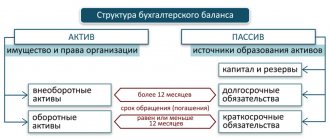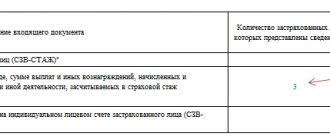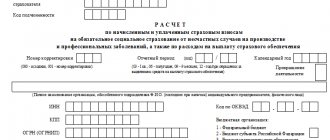Encyclopedia of solutions. Interest receivable and payable (lines 2320 and 2330)
Interest receivable and payable (lines 2320 and 2330)
Line 2320 “Interest receivable” of the Statement of Financial Results (hereinafter referred to as the Report) indicates the income due to the organization in the form of interest:
- for loans issued to other persons;
- on deposits placed in banks for the purpose of generating income;
— on bonds and other securities (for example, financial bills);
— accrued by the bank based on the balance of funds on the organization’s current account (clause 7 of PBU 9/99 “Income of the organization”, hereinafter referred to as PBU 9/99).
Such income is taken into account as part of other credit account 91 “Other income and expenses” in correspondence with account 76 “Other debtors and creditors” (when providing a loan to an employee with account 73) (clause 7 PBU 9/99, clause 34 PBU 19 /02 “Accounting for financial investments”).
Thus, line 2320 of the Report reflects the credit turnover in account 91, subaccount “Other income” in terms of accounting for interest receivable
Income in the amount of interest due is reflected on line 2320 only if it is included in the organization’s other income (clause 7 of PBU 9/99). If receiving this kind of income is one of the main activities of the organization, their amount is entered not in line 2320, but in line 2110 “Revenue” of the Report (clause 4 of PBU 9/99).
According to clause 16 of PBU 9/99, interest received for the provision of funds to an organization for use is recognized in a manner similar to that provided for in clause 12 of PBU 9/99. In turn, clause 12 of PBU 9/99 determines that income is recognized in accounting when the following conditions are met:
a) the organization has the right to receive it, arising from a specific agreement or confirmed in another appropriate manner;
b) the amount of income can be determined;
c) there is confidence that as a result of a particular transaction there will be an increase in the economic benefits of the organization. Such assurance exists when the entity has received an asset as payment or there is no uncertainty regarding receipt of the asset.
At the same time, in accounting, interest is accrued for each expired reporting period in accordance with the terms of the agreement (clause 16 of PBU 9/99).
Line 2330 “Interest payable” indicates the amount of interest that the organization must pay, in particular:
— for all types of debt obligations (loans, credits) (clause 11 of PBU 10/99 “Expenses of the organization” (hereinafter referred to as PBU 10/99);
— issued bills or bonds (clauses 15, 16 PBU 15/2008 “Accounting for expenses on loans and credits”).
The procedure for recognizing such expenses is regulated by PBU 10/99.
Expenses are recognized in accounting only if the conditions listed in clause 16 of PBU 10/99 are met, namely:
— the expense is made in accordance with a specific agreement, the requirements of legislative and regulatory acts, and business customs;
— the amount of expense can be determined;
- there is confidence that as a result of a particular transaction there will be a decrease in the economic benefits of the organization.
In this case, expenses are subject to recognition in accounting, regardless of the intention to receive revenue, other or other income and the form of expenditure (monetary, in-kind and other) (clause 17 of PBU 10/99).
In accounting, interest payable is reflected in the debit of account 91 “Other income and expenses”, subaccount “Other expenses”:
Conditions affecting loan accounting
A loan is a transfer of funds (or other means of payment) on debt that occurs between individuals or legal entities, as well as between a legal entity and an individual. A credit institution never participates in this procedure, since operations with its participation, despite the same nature of the relationship, have different names: loan and deposit (for an individual) or deposit (for a legal entity).
Accounting entries arise only for legal entities that can both borrow funds from legal entities or individuals and give them to the same entities, but the nature of the accounting entries does not depend on with whom exactly (a legal entity or individual) the borrowing agreement was concluded. At the same time, there are points that affect the correspondence of accounts used in these records.
Interest on a loan issued - postings
Funds issued as a loan, subject to the accrual of interest on them by the transferring party, are always taken into account as part of financial investments, i.e. in account 58. The issue is recorded by posting Dt 58 Kt 51 (50, 52).
IMPORTANT! An interest-free loan will not be shown on account 58, since it does not correspond to the very idea of financial investments (to generate income). Its amount should be shown on account 76 (Dt 76 Kt 51 (50, 52)).
At the same time, in transactions for calculating interest on a loan issued, another account will be used - 76. Its use will lead to the appearance of a transaction - interest accrued on a loan issued - with correspondence Dt 76 Kt 91 (90). The choice of account in the credit part of this record will determine which types of activities for the lender include issuing a loan: other (in which case account 91 will be used) or ordinary (in this case account 90 will be used).
Interest calculations by organizations are carried out monthly on the last date of this period (clauses 12, 16 of PBU 9/99, approved by order of the Ministry of Finance of Russia dated 05/06/1999 No. 32n).
Neither the loan amount itself nor the interest on it are subject to VAT (subclause 15, clause 3, article 149 of the Tax Code of the Russian Federation), i.e., there will be no postings regarding this tax on the debit of account 91 (90). If the lender has any costs associated with issuing a loan (for example, a fee to the bank for funds transfer services), then during the period of their implementation they will be debited to account 91 (90).
The receipt of interest payments will be expressed by posting Dt 51 (50, 52) Kt 76.
How to calculate interest on a loan
If the count is monthly, you need to accurately indicate the number of days in the month: 30, 31, 28, 29.
Accruals are carried out starting from the day following the day of conclusion of the agreement and receipt of money, up to and including the day on which the funds will be returned. You should know how to calculate interest on a loan; the ability to determine your expenses will help not only pay accurately, but also make sure that the lender is honest with its borrower.
Especially when it comes to private loans between individuals. How to calculate interest on a loan using formulas Despite the fact that there are many loan calculators on the Internet, it does not hurt to know the calculation mechanism, especially when it comes to loans between individuals.
Interest accrued on the loan received - postings
The recipient of the borrowed funds will have their receipt recorded either in account 66 (if the loan is short-term - up to a year) or in account 67 (if the funds are taken for a period exceeding 12 months). The wiring will be as follows: Dt 51 (50, 52) Kt 66 (67).
The accrued interest will be credited to these same accounts, separating them in the accounting analytics from the amount of the principal debt. That is, in the entry for calculating interest on a loan received in the credit part there will be an account 66 or 67. The choice of the account that falls into its debit part will determine the fact of use or non-use of the funds received when creating an investment asset (clause 7 of PBU 15/2008, approved by order of the Ministry of Finance of Russia dated October 6, 2008 No. 107n).
Interest amounts on a loan that is not related to the creation of an asset regarded as an investment (it has a long period of creation and high cost) should always be taken into account in other expenses - Dt 91 Kt 66 (67), accruing the corresponding amounts monthly (clause 6 of PBU 15/2008).
If borrowed funds are involved in expensive long-term investments, then the interest on them will form the cost of property (fixed assets or intangible assets) created with the participation of the corresponding investments: Dt 08 Kt 66 (67). During a long (more than 3 months) break that arose in the process of making investments, and upon completion of investments in the object, the continuing accrual of interest on the loan should be included in other expenses (clauses 11, 13 of PBU 15/2008).
Simple interest formula
The simple interest formula is applied if the interest accrued on the deposit is added to the deposit only at the end of the deposit period or is not added at all, but is transferred to a separate account, i.e. calculation of simple interest does not provide for the capitalization of interest.
When choosing the type of deposit, you should pay attention to the procedure for calculating interest. When the deposit amount and placement period are significant, and the bank uses the simple interest formula, this leads to an underestimation of the depositor's interest income. The formula for simple interest on deposits looks like this:
Simple interest formula
Meaning of symbols: S - the amount of funds due to be returned to the depositor at the end of the deposit period. It consists of the original amount of money placed plus accrued interest. I – annual interest rate t – number of days of accrual of interest on the attracted deposit K – number of days in the calendar year (365 or 366) P – initial amount of funds attracted to the deposit Sp – amount of interest (income).
And to calculate only the amount of simple interest, the formula will look like this:
Simple interest formula
Meaning of symbols: Sp – amount of interest (income). I – annual interest rate t – number of days of interest accrual on the attracted deposit K – number of days in a calendar year (365 or 366) P – amount of funds attracted to the deposit.
I will give conditional examples of calculating simple interest and the amount of a bank deposit with simple interest:
Example 1.
Let's assume that the bank accepted a deposit in the amount of 50,000 rubles for a period of 30 days. Fixed interest rate - 10.5% per annum. Applying the formulas, we obtain the following results:
S = 50000 + 50000 * 10.5 * 30 / 365 / 100 = 50431.51
Sp = 50000 * 10.5 * 30 / 365 / 100 = 431.51
Example 2.
The bank accepted a deposit in the same amount of 50,000 rubles for a period of 3 months (90 days) at a fixed rate of 10.5 percent per annum. Only the investment term has changed in the conditions.
S = 50000 + 50000 * 10.5 * 90 / 365 / 100 = 51294.52
Sp = 50000 * 10.5 * 90 / 365 / 100 = 1294.52
When comparing the two examples, it is clear that the amount of monthly accrued interest using the simple interest formula does not change.
431.51 * 3 months = 1294.52 rubles.
Example 3.
The bank accepted a deposit in the amount of 50,000 rubles for a period of 3 months (90 days) at a fixed rate of 10.5 percent per annum. The deposit is replenished, and on the 61st day the deposit was replenished in the amount of 10,000 rubles.
S1 =50000 + 50000 * 10.5 * 60 / 365 / 100 = 50863.01 Sp1 = 50000 * 10.5 * 60 / 365 / 100 = 863.01
S2 = 60000 + 60000 * 10.5 * 30 / 365 / 100 = 60517.81 Sp2 = 60000 * 10.5 * 30 / 365 / 100 = 517.81
Sp = Sp1 + Sp2 = 50000 * 10.5 * 60 / 365 / 100 + 60000 * 10.5 * 30 / 365 / 100 = 863.01 + 517.81 = 1380.82
Example 4.
The bank accepted a deposit in the same amount of 50,000 rubles for a period of 3 months (90 days), at a floating rate. For the first month (30 days) the interest rate is 10.5%, for the next 2 months (60 days) the interest rate is 12%.
S1 = 50000 + 50000 * 10.5 * 30 / 365 / 100 = 50000 + 431.51 = 50431.51 Sp1 = 50000 * 10.5 * 30 / 365 / 100 = 431.51
S2 = 50000 + 50000 * 12 * 60 / 365 / 100 = 50000 + 986.3 = 50986.3 Sp2 = 50000 * 12 * 60 / 365 / 100 = 986.3
Sp = 50000 * 10.5 * 30 / 365 / 100 + 50000 * 12 * 60 / 365 / 100 = 431.51 + 986.3 = 1417.81
Definition
Interest receivable
– income received in connection with the provision of debt financing to third parties, namely:
interest due to the organization on loans issued by it;
interest and discount receivable on securities (for example, bonds, bills);
interest on commercial loans provided by transfer of advance payment, prepayment, deposit;
interest paid by the bank for the use of funds located in the organization’s current account, etc.
Interest receivable is (clause 4 of PBU 9/99):
an independent type of income – if, in accordance with the company’s activities, such income is classified as other;
component of sales revenue, if, in accordance with the company’s activities, such income is recognized as income from ordinary activities.
How is interest receivable calculated?
Interest receivable is recognized as income in accordance with the terms of the agreements on the basis of which financing was provided to third parties, and the terms of the issue of securities (clause 16 of PBU 9/99).
Interest receivable is taken into account (Instructions for using the Chart of Accounts):
on the credit of account 91 “Other income and expenses”, subaccount “Other income” in correspondence with account 76 “Settlements with various debtors and creditors” - if, in accordance with the areas of the company’s activities, such income is classified as other;
on the credit of account 90 “Sales”, subaccount “Revenue” in correspondence with account 76 “Settlements with various debtors and creditors” - if, in accordance with the areas of the company’s activities, such income is recognized as income from ordinary activities.
Reflection of interest receivable in financial statements
Interest receivable is reflected:
on line 2320 “Interest receivable” of the Statement of Financial Results - if, in accordance with the areas of the company’s activities, such income is classified as other;
on line 2110 “Revenue” of the Statement of Financial Results - if, in accordance with the areas of the company’s activities, such income is recognized as income from ordinary activities.
Still have questions about accounting and taxes? Ask them on the accounting forum.
Interest receivable
reflected:
- on line 2110 “Revenue” of the Statement of Financial Results - if, in accordance with the areas of the company’s activities, such income is recognized as income from ordinary activities.
- on line 2320 “” of the Statement of Financial Results - if, in accordance with the areas of the company’s activities, such income is classified as other;
Cm.
This will allow you to check the accuracy of upcoming payments, as well as predict payments in various circumstances, for example, in case of delay.
See also: Still have questions about accounting and taxes? Ask them at . : details for an accountant
- . ) Amount Including 1 (income) 73,777 All for . Calculate interest payable and interest receivable. Loan No. 1. 1,000,000. income (expense) Amount Note 1 (income) 84,065 Interest calculated.
3.2.8.1. What is related to interest receivable?
Interest receivable by the organization includes (clause 7 of PBU 9/99, Instructions for the use of the Chart of Accounts):
- interest due to the organization on loans issued by it;
— interest and discount receivable on securities (for example, bonds, bills);
— interest on commercial loans provided by transferring an advance, prepayment, or deposit;
— interest paid by the bank for the use of funds located in the organization’s current account.
Interest is recognized as income for the expired reporting period in accordance with the terms of contracts (clause 16 of PBU 9/99).
Interest receivable. Line 2320
This line reflects information about the organization’s income in the form of interest due to it, which is other income for the organization (clause 18 of PBU 9/99).
What is related to interest receivable?
Interest receivable by the organization includes (clause 7 of PBU 9/99, Instructions for using the Chart of Accounts):
- interest due to the organization on loans issued by it;
— interest and discount receivable on securities (for example, bonds, bills);
— interest on commercial loans provided by transferring an advance, prepayment, or deposit;
— interest paid by the bank for the use of funds located in the organization’s current account.
Interest is recognized as income for the expired reporting period in accordance with the terms of contracts (clause 16 of PBU 9/99).
Note that interest receivable by the organization is shown on line 2320 “Interest receivable” only if it qualifies it as other income and is reflected in the accounting records under the credit of account 91 “Other income and expenses”, subaccount 91 -1 “Other income” (clause 4 of PBU 9/99).
If the interest due to an organization is income for it from ordinary activities (as, for example, for pawnshops), then they form the indicator of line 2110 “Revenue”.
What accounting data is used when filling out line 2320 “Interest receivable”?
The value of the indicator in line 2320 “Interest receivable” (for the reporting period) is determined on the basis of data on the total credit turnover for the reporting period in subaccount 91-1 of account 91, the analytical account for interest receivable.
Line 2320 “Interest receivable” = Loan turnover of subaccount 91/1 (analytical accounting account % receivable)
The indicator in line 2320 “Interest receivable” (for the same reporting period of the previous year) is transferred from the Statement of Financial Results for this reporting period of the previous year.
Example of filling out line 2320 “Interest receivable”
Indicators for subaccount 91-1 of account 91 in accounting (in terms of accrued interest receivable): rub.
| Turnover for the reporting period (2014) | Sum |
| 1 | 2 |
| 1. For the loan of subaccount 91-1, analytical account for interest receivable | 281 160 |
Fragment of the Financial Results Report for 2013
| Explanations | Indicator name | Code | For 2013 | For 2012 |
| 1 | 2 | 3 | 4 | 5 |
| Interest receivable | 2320 | 133 | 160 |
Solution
The amount of interest receivable for the reporting period is 281 thousand rubles.
A fragment of the Income Statement will look like this.
| Explanations | Indicator name | Code | For 2014 | For 2013 |
| 1 | 2 | 3 | 4 | 5 |
| Interest receivable | 2320 | 281 | 133 |







